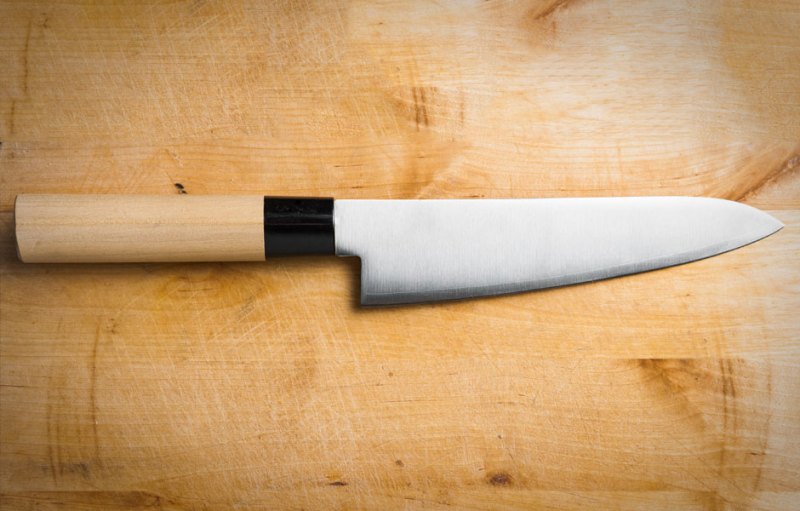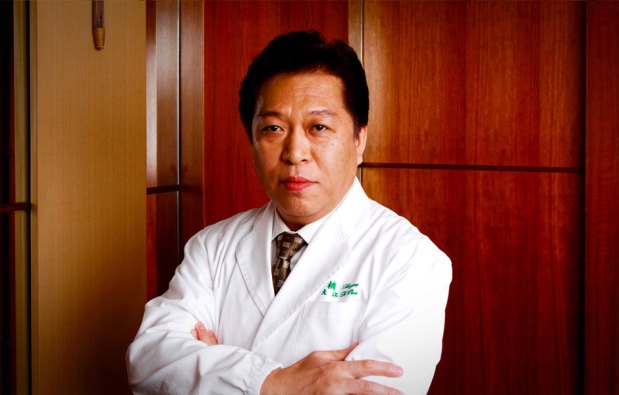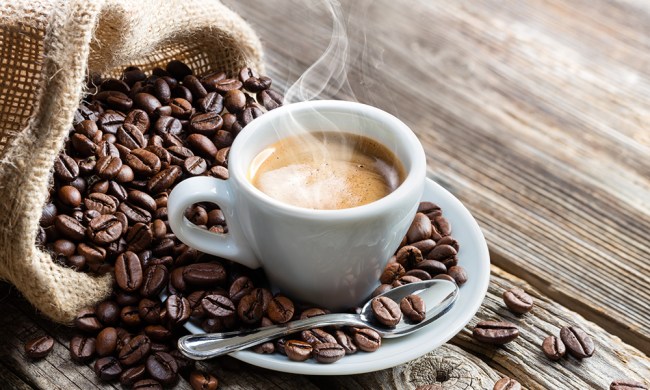
“To cut is to cook.” This notion is king in Japanese cuisine, but anyone who spends a lot of time in the kitchen knows how much truth the saying holds. Owning and knowing how to use high quality knives is one of the most important parts of mastering your cooking skills. So we enlisted the help of Kenichiro Ooe, the chef of Kozue at Park Hyatt Tokyo, to walk us through which knives are essential and how to use them properly.
As one of the few chefs government licensed to prepare Fugu, or deadly blowfish, his expert knowledge is unparalleled. “It it is my partner [the knife],” Chef Ooe says. “It knows my successes and tough times; the things I’ve learned it has also learned. It is the instrument that takes food from ingredient to cuisine.” In western cooking, knives are categorized by the task they were designed to perform. But Japanese knives are chosen based on length, thickness, steel quality and the type of cuisine for which they’re to be used. Chef Ooe explains these classifications in depth, talks cutting techniques and reveals his favorite brands of knives below.
What are the three knives everyone should have in his kitchen?
A professional chef will choose each knife for the produce and cuisine at hand. But for those cooking at home, I would recommend having the following three knives as a minimum:
– A vegetable knife (Usuba bocho)
– A pointed cleaver or carving knife (Deba bocho) for filleting whole fish, game and meat on the bone
– An elongated sashimi or carving knife (Yanagiba bocho) for slicing sashimi or pre-filleted fish and meat
A butcher’s style knife is also handy to have, but there’s a tendency to rely on this one blade too heavily. I recommend people make a conscious effort to select a knife based on the task at hand.
What is the best knife to use for red meat? Are there certain dimensions that make the most sense ( length, thickness, handle width, etc)? Is there a special way one should cut red meat?
For cutting meat on the bone, I would recommend a Deba bocho, approximately 15cm to 18cm in length. The handle is typically oval or octagonal, the latter being easier to grip. For meat that has already been removed from the bone, choose between a Deba bocho or Yanagiba bocho, 21cm to 30cm in length. Again, there are two handle shapes, but the octagonal is easier to grip. One should take care not to force the knife downward, but rather slide it back and forth to slice the meat.
For fish, what is the best knife? Is there a knife that is better for raw fish and another knife that’s better for cooked fish? Is there a special way one should cut fish, both raw and cooked?
The same can be said for fish. When filleting a whole fish, one should use a Deba bocho. When slicing sashimi, grab for a Yanagiba bocho. When slicing fillets, you can choose either of these blades. When using the Yanagiba bocho blade for sashimi, raise the blade tip to a 45 degree angle from the board and slice from the knife base to tip in a smooth pulling action, lowering the tip as you pull. You shouldn’t slide the blade back and forth. Also, a longer blade helps prevent fatigue when preparing large amounts.
For vegetables, which knife do you recommended? Is there a recommended technique for chopping vegetables? Will certain chopping actually dull the knife?
For vegetables, I recommend using a Usuba bocho, 16cm to 22cm in length with a rectangular or sickle shaped handle. The blade should be broad when viewed from the side but thin from above. One would use this for peeling and chopping vegetables. In western cooking, one typically places the knife tip on the chopping board and presses the handle end down to cut. But in Japanese cuisine, we hold the knife away from the chopping board, resting the side of the blade against the edge of the index finger on the supporting (left) hand and slice away from the body using the top 5cm of the blade.
The best way to limit damage to a knife, from a purely theoretical standpoint, is to reduce contact with and pressure to the chopping board. You’re cutting the vegetables, not the board, after all. Keeping this point in mind should help. One should avoid needless pummeling or hacking and remember to clean the blade soon after you’ve finished cutting or slicing. For the one-edged blades mentioned earlier, one should never use a pole-shaped sharpening steel, as it will destroy the blade.

What is the one knife you would buy for someone as a gift and why?
If I was to buy a knife for a cooking professional or someone with strong culinary interest, a set of the three knifes would be my choice. If I had to choose one though, it would be the Yanagiba bocho. While it isn’t particularly suited for cutting vegetables, it is otherwise quite versatile and very sharp. Further, when it is given a mirror finish, the Yanagiba bocho takes on a beautiful appearance not dissimilar to a Japanese sword, making it somewhat of a work of art.
What is the most important technique, skill or upkeep you’ve learned for knives?
There are four professional techniques that are equally as important. First, for vegetables, there is the technique of cutting daikon radish into a thin sheet in a peeling motion. Secondly, there’s the method of then slicing the daikon radish sheets into fine (evenly sized) threadlike strips. Third, for fish, there’s the technique of filleting a whole fish into three fillets so no bones are left in the flesh. Fourth, again for fish, there’s a way to remove the skin from a white fish and thinly slice it for sashimi, such as one might do for puffer fish. If one can master these four techniques, then he or she should be capable of doing most other things.
For the average person in the kitchen, the starting point is to ensure he or she uses the blade to slice or cut, moving it smoothly back and forth if necessary, rather than placing the blade tip on the cutting board and chopping the produce. This is true for everything from bread to tomatoes. It should be the blade that cuts, not the pressure you place on it from above.
What is your favorite knife brand?
There are various brands to choose from, but currently I’m fond of my knife with steel forged by Genkai Masakuni with a blade crafted by Minamoto no Hakuho. In terms of brands, I am fond of Fudo Kuniyuki, Unryu Kuniyuki, Hiryu Kuniyuki and Koho Masakuni. Even the average person should use a quality knife, as dull knives are a source of injuries. Again, while there are multiple brands to choose from, I’d recommend some that are popular with those starting out as culinary professionals, such as the Honkasumi-steel blades from Aritsugu and Masamoto. One of these will become the pride of anyone’s kitchen.
Are there any custom, high-end knife makers you recommend in Tokyo that also sell knives stateside?
Yes, there is one shop in New York City that stocks genuine Japanese knives – KORIN at 57 Warren Street. They carry a splendid selection of knives, with their original KORIN brand offering everything from knives for the beginner through to the budding and expert chefs. I have one myself. They have a selection of other brands too, catering to all skill levels. Another wonderful point about this shop is they’ll sharpen your knife each time you take it into the store.
What is the best knife for a novice chef? What about an expert chef? Is there really a big difference?
In the simplest of terms, the difference between any knives comes from the quality of steel used and how they’re crafted. Apprentices are best off starting with a blade made from softer, suppler, cheaper steel, such as Honkasumi, and using it to hone their sharpening and cutting technique. I would recommend the more advanced professional use a blade made from a sharper, longer lasting steel such as Mizuyaki Honyaki. In terms of knife types, I would recommend the three mentioned earlier (Usuba, Deba, Yanagiba) and a fourth butcher style knife (western or Japanese) as a base. As proficiency improves, you could work towards using the harder Mizuyaki Honyaki knives.
It doesn’t matter how wonderful and expensive a knife is, it will become rusty and dull if it’s not properly maintained. You should clean all dirt and oil from the blade to the handle every day. I also recommend sharpening knives daily, then lightly washing and using a dry towel to remove all moisture before storing. You can get away with sharpening when the blade dulls a little but should make sure everything else is carried out without fail.
If maintained properly, even a cheap knife can cut well. The converse can be said of an expensive knife. Working with a dull knife, even the most renowned chefs cannot create delicious, beautiful food in a timely manner. In short, using a properly sharpened knife is the most important thing to remember.



